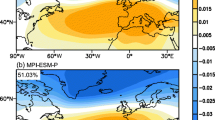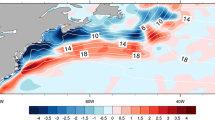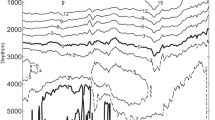Abstract
Large ensembles of simulations (ensemble size of 500 members) are performed using a simplified atmospheric general circulation model (AGCM) in order to investigate the non-linearities in the response to composite sea surface temperature (SST) anomaly forcings that are constant in time. The SST composite corresponds to the observed anomaly associated with the atmospheric North Atlantic Oscillation (NAO). The integration length is 90 days for each ensemble (covering January, February and March). A non-linearity is found in the mean response to the SST-forcing, with the negative SST-NAO forcing leading to a stronger and more clear atmospheric NAO response. These non-linearities appear to be due to asymmetries in the heating anomalies induced by the SST-forcing and asymmetries in the transient eddy vorticity forcing. Further non-linearities are due to initial period dependences of the response to the same SST-forcing. As a consequence, a pre-existing negative atmospheric NAO is much more persistent due to SST-feedback than a positive NAO.










Similar content being viewed by others
References
Czaja A, Frankignoul C (2002) Observed impact of Atlantic SST anomalies on the North Atlantic Oscillation. J Clim 15: 606–623
Held IM, Kang I-S (1987) Barotropic models of the extratropical response to El Nino. J Atmos Sci 44: 3576–3586
Hoerling MP, Hurrel JW, Xu T (2001) Tropical origins for recent North Atlantic climatic change. Science 292: 90–92
Hurrell JW (1995) Decadal trends in the North Atlantic Oscillation: regional temperature and precipitation. Science 269: 676–679
Josey SA, Kent EC, Sinha B (2001) Can a state of the art atmospheric general circulation model reproduce recent NAO related variability at the air–sea interface? Geophys Res Lett 28(24): 4543–4546
Marshall J, Kushnir Y, Battisti D, Chang P, Czaja A, Dickson R, Hurrell J, McCartney M, Saravanan R, Visbeck M (2001) North Atlantic climate variability: phenomena, impacts and mechanisms. Int J Climatol 21: 1863–1898
Mehta VM, Suarez MJ, Manganello JV, Delworth TL (2000) Oceanic influence on the North Atlantic Oscillation and associated Northern Hemispheric climate variations: 1959–1993. Geophys Res Lett 27(1): 121–124
Molteni F (2003) Atmospheric simulations using a GCM with simplified physical parameterizations. I. Model climatology and variability in multi-decadal experiments. Clim Dyn 20: 175–191
Orlanski I, Katzfay J (1991) The life cycle of a cyclone wave in the Southern Hemisphere. Part I: eddy energy budget. J Atmos Sci 48: 1972–1998
Peng S, Whitaker JS (1999) Mechanisms determining the atmospheric response to midlatitude SST anomalies. J Clim 12: 1393–1408
Peng S, Mysak LA, Ritchie H, Derome J, Dugas B (1995) The differences between early and midwinter atmospheric responses to sea surface temperature anomalies in the northwest Atlantic. J Clim 8: 137–157
Peng S, Robinson WA, Hoerling MP (1997) The modeled atmospheric response to midlatitude SST anomalies and its dependence on background circulation states. J Clim 10: 971–987
Robinson WA (2000) Review of WETS – The workshop on extratropical SST anomalies. Bull Am Meteorol Soc 81: 567–577
Rodwell MJ, Rowell DP, Folland CK (1999) Oceanic forcing of the wintertime North Atlantic Oscillation and European climate. Nature 398: 320–323
Smith TM, Reynolds RW, Livezey RE, Stokes DC (1996) Reconstruction of historical sea surface temperatures using empirical orthogonal functions. J Clim 9: 1403–1420
Sutton RT, Warwick AN, Jewson SP (2000) The North Atlantic Oscillation – what role for the ocean? Atmos Sci Lett: doi:10.1006/asle.2000.0018
Watanabe M, Kimoto M (2000) Atmospheric–ocean thermal coupling in the North Atlantic: a positive feedback. Q J R Meteorol Soc 126: 3343–3369
Acknowledgements.
The authors wish to thank Frank Selten for initial discussions about this study and the two anonymous referees for their valuable and constructive suggestions.
Author information
Authors and Affiliations
Corresponding author
Rights and permissions
About this article
Cite this article
Kucharski, F., Molteni, F. On non-linearities in a forced North Atlantic Oscillation. Climate Dynamics 21, 677–687 (2003). https://doi.org/10.1007/s00382-003-0347-z
Received:
Accepted:
Published:
Issue Date:
DOI: https://doi.org/10.1007/s00382-003-0347-z




